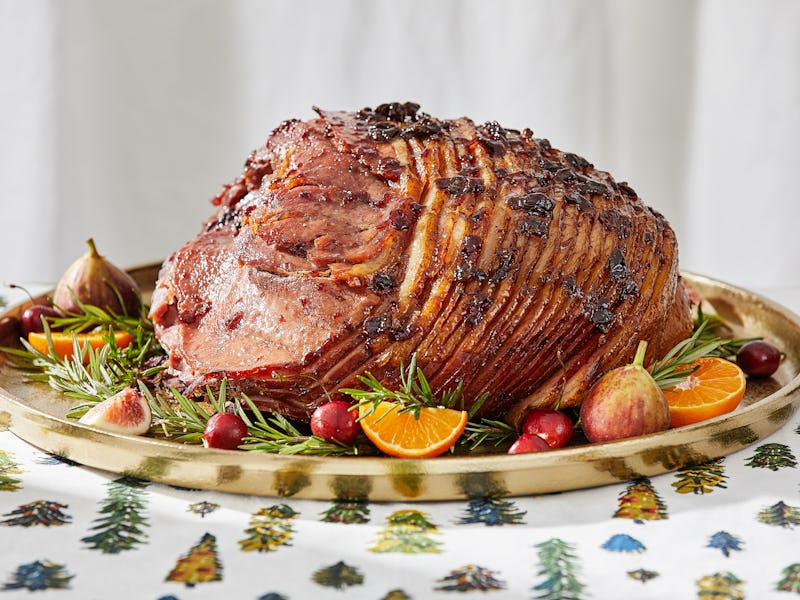The Most Delicious Holiday Meat Is a Miracle of Modern Science
“There's a lot of chemistry that's going on.”

This time of year, turkey gets a lot of attention. But let’s be real, turkey is massively overrated. It's dry. It’s flavorless. And cooking it wrong can burn down your house.
Enter: ham, the oft-forgot holiday centerpiece that packs a hardier punch when it comes to flavor, juiciness, and color.
Although most Americans associate ham with a large slab of cured pork, ham is a catch-all term for the cut of meat taken from the chunky part of a pig’s hind leg. But the curing process that transforms it from a generic piece of pork into a quintessential holiday ham is deeply rooted in science. From ham’s bold flavor to its rosy hue and admirable shelf life, “there's a lot of chemistry that's going on,” Wes Osburn, an associate professor of animal science at Texas A&M University, tells Inverse.
Here’s what you need to know about the science behind ham, and how the curing process affects everything from the way your dinner tastes to how long it lasts in your fridge.
How Do You Make White Meat Pink?
It takes heat to get ham’s famous blush tone.
Curing meat — the process that changes a meat’s color, among other shifts, from white to pink — starts with one of two chemical compounds: sodium nitrite or sodium nitrate. When added to meat, these compounds interact with water molecules found naturally in the meat. Together, they undergo a series of chemical reactions that ultimately form nitric oxide, aka, the curing molecule.
Nitric oxide then reacts with iron in myoglobin, a muscle protein found in most vertebrates. Myoglobin transports oxygen in muscle, much like hemoglobin does in the blood. This new reaction creates a pigment called nitrosomyoglobin, a dark red color that appears in cured meat that hasn’t yet been exposed to heat.
Finally, to get ham’s famous blush tone, the meat needs heat, which changes the NO-nitrosomyoglobin combo into a heat-stable pigment called nitrosochemochrome.
Voila! Pink meat.
Many commercial meat curing processors add a reducing agent, such as sodium erythorbate or ascorbic acid, which is really just Vitamin C, to the beginning of the process. These agents convert nitrite to nitrous acid, which is then reduced to nitric oxide. From there, the process stays the same, just sped up a bit.
In recent years, some companies have shied away from using synthetic nitrites (which some consumers want to avoid) in their curing process. To get around this, they use natural nitrites derived from raw spinach, beets, celery, and lettuce. According to Gary Sullivan, an associate professor of meat science at the University of Nebraska, Lincoln, these meats can be labeled as “uncured” under current Food and Drug Administration guidelines, but the process these so-called “natural nitrites” inflict on the meat essentially the same as sodium nitrite and sodium nitrate.
The Long Game
Curing ham also increases its shelf life.
The curing process isn’t just for show or flavor, it’s also an extremely effective way to preserve the meat’s shelf life.
When uncured meat is exposed to warmth and light, it kicks off a process called oxidation. During oxidation, all the fat that makes pork so juicy also releases free radicals (molecules that have at least one unpaired, “free” valence electron, the ones on the outermost shell of an atom, which can cause damage to other cells).
As a result, the meat fills with an aldehyde, or organic compound, called malondialdehyde. This gives meat a rancid taste and smell once it’s gone off. Curing drastically slows this from happening, thus preserving the meat for much longer than it would otherwise exist in a meat case without going bad.
“Nothing is permanently preserved, but curing does extend the shelf life, particularly of products that contain a lot of fat,” says Osburn.
The salt added during the curing process has also long been used as a way to ward off pathogens. Sodium slows the growth of botulism toxin, one of the most common causes of foodborne illness.
“You have some level of safety that’s added to the product,” Sullivan says.
Flavor Saver
The flavor of ham has evolved over time.
Changing the way pork fat oxidizes through curing also creates a distinct flavor. “A lot of flavors are associated with fat-derived compounds,” Sullivan explains.
While meat cures, nitric oxide reduces oxidation of these compounds. This creates less diversity of flavor compounds, which changes the way the meat tastes.
Nitric oxide’s relationship with iron also impacts flavor. On its own, iron is pro-oxidative, meaning it promotes free radicals. But when nitric oxide binds to the iron in myoglobin, it stabilizes the iron and creates an antioxidant effect. That, along with the added salt from the curing agent, creates new flavors in the meat. These can be amplified with other treatments after the meat’s done curing.
Though an icon of tradition, the flavor of the Christmas ham has a long history of evolution. These days, it’s not uncommon for producers to add honey glazes, sugar, and synthetic smoke flavor to ham to further change or enhance the meat’s natural slightly sweet-savory flavor.
“Back in the day, a lot of people would get fresh ham and use it for Christmas, but now we’ve gone into cured ham, then boneless ham, now into the honey-baked and all that,” Sullivan says. “It’s changed based on people’s preferences and how much time they want to spend cooking.”
This article was originally published on